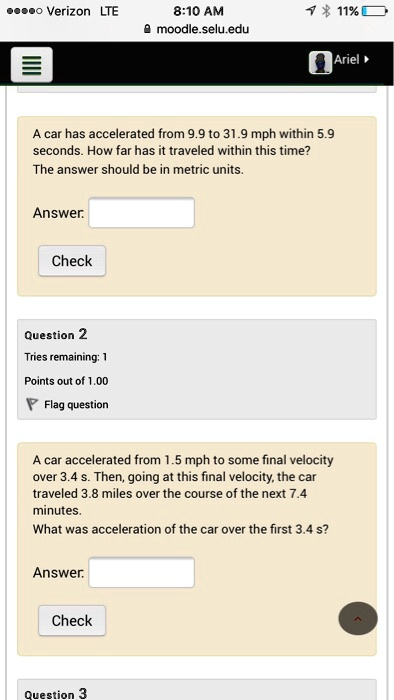Acco Verizon LTE 8:10 AM 11% [ moodle selu edu Ariel The car has accelerated from 0 to 31.9 mph within 5.9 seconds. How far has it traveled within this time? The answer should be in metric units. Answer Check Question 2 Tries remaining; Points out of Flag question The car accelerated from mph to some final velocity over 3.4 s. Then, going at this final velocity, the car traveled miles over the course of the next 7.4 minutes. What was the acceleration of the car over the first 3.4 s? Answer Check Question 3

The Correct Answer and Explanation is:
Here are the correct answers and a detailed explanation for the two physics problems in the image.
Answer for Question 1: 55.1 meters
Answer for Question 2: 3.9 m/s²
Explanation for Question 1
To find the distance the car traveled, we can use a standard kinematic equation. The problem requires the answer in metric units, so we must first convert the given velocities from miles per hour (mph) to meters per second (m/s). The conversion factor is that 1 mph is approximately 0.44704 m/s.
- Initial velocity (v₀): 9.9 mph × 0.44704 m/s/mph ≈ 4.43 m/s
- Final velocity (v): 31.9 mph × 0.44704 m/s/mph ≈ 14.26 m/s
- Time (t): 5.9 seconds
The formula for distance (d) when acceleration is constant is d = ((v₀ + v) / 2) × t. This equation finds the average velocity and multiplies it by the time interval.
Plugging the metric values into the formula:
d = ((4.43 m/s + 14.26 m/s) / 2) × 5.9 s
d = (18.69 m/s / 2) × 5.9 s
d = 9.345 m/s × 5.9 s
d ≈ 55.1 meters
Explanation for Question 2
This problem involves two distinct stages of motion. We must first determine the car’s velocity from the second stage to calculate the acceleration during the first stage.
Stage 2: Constant Velocity
First, we find the constant velocity (which we’ll call v_f) the car traveled at. We use the formula: velocity = distance / time. All units must be converted to metric.
- Distance: 3.8 miles × 1609.34 m/mile = 6115.5 meters
- Time: 7.4 minutes × 60 s/min = 444 seconds
- v_f = 6115.5 m / 444 s ≈ 13.77 m/s
Stage 1: Acceleration
This constant velocity (13.77 m/s) is the final velocity achieved during the initial acceleration phase. Now we have the necessary information for the first stage:
- Initial velocity (v₀): 1.5 mph × 0.44704 m/s/mph ≈ 0.67 m/s
- Final velocity (v_f): 13.77 m/s
- Time (t): 3.4 seconds
We can now find the acceleration (a) using the formula a = (v_f – v₀) / t.
a = (13.77 m/s – 0.67 m/s) / 3.4 s
a = 13.1 m/s / 3.4 s
a ≈ 3.85 m/s²
Rounding to two significant figures, consistent with the given data, the acceleration is 3.9 m/s².thumb_upthumb_down
